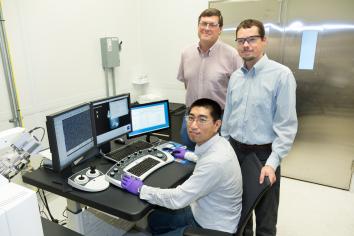«We discovered somewhat by accident that this material worked," said ORNL’s Adam Rondinone, lead author of the team’s study published in ChemistrySelect. «We were trying to study the first step of a proposed reaction when we realized that the catalyst was doing the entire reaction on its own.»
 The team used a catalyst made of carbon, copper and nitrogen and applied voltage to trigger a complicated chemical reaction that essentially reverses the combustion process. With the help of the
The team used a catalyst made of carbon, copper and nitrogen and applied voltage to trigger a complicated chemical reaction that essentially reverses the combustion process. With the help of the
«We’re taking carbon dioxide, a waste product of combustion, and we’re pushing that combustion reaction backwards with very high selectivity to a useful fuel," Rondinone said. «Ethanol was a surprise — it’s extremely difficult to go straight from carbon dioxide to ethanol with a single catalyst.»
The catalyst’s novelty lies in its nanoscale structure, consisting of copper nanoparticles embedded in carbon spikes. This
«By using common materials, but arranging them with nanotechnology, we figured out how to limit the side reactions and end up with the one thing that we want," Rondinone said.
The researchers’ initial analysis suggests that the spiky textured surface of the catalysts provides ample reactive sites to facilitate the carbon
 «They are like
«They are like
Given the technique’s reliance on
«A process like this would allow you to consume extra electricity when it’s available to make and store as ethanol," Rondinone said. «This could help to balance a grid supplied by intermittent renewable sources.»
The researchers plan to refine their approach to improve the overall production rate and further study the catalyst’s properties and behavior.
ORNL’s Yang Song, Rui Peng, Dale Hensley, Peter Bonnesen, Liangbo Liang, Zili Wu, Harry Meyer III, Miaofang Chi, Cheng Ma, Bobby Sumpter and Adam Rondinone are coauthors on the study, which is published as «
The work was supported by DOE’s Office of Science and used resources at the ORNL’s Center for Nanophase Materials Sciences, which is a DOE Office of Science User Facility.
Source: https://www.ornl.gov/news/nano-spike-catalysts-convert-carbon-dioxide-directly-ethanol


